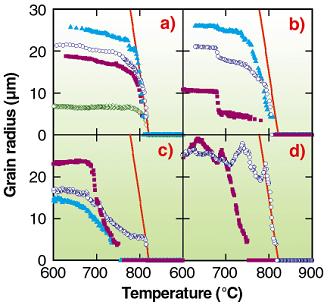Transformation kinetics of the austenite to ferrite transformation in steel
Grain nucleation and growth are important phenomena in polycrystalline materials like metals and most ceramics. They govern the kinetics of many phase transformations and recrystallisation processes that take place during processing. The final average grain size after the transformation is directly related to the strength of the material. In general a smaller average grain size results into a stronger material. Despite the various transformation models that have been proposed in the last 60 years, the kinetics of these phase transformations are still poorly understood. Most of these models are based upon the Classical Nucleation Theory (CNT) and the law of parabolic grain growth as derived by Zener, which describe the behaviour of individual grains in the bulk of the material.
The experimental techniques which have been available to verify these nucleation and growth models are either limited to observations at the surface or the determination of the average grain growth behaviour in the bulk. We have applied in-situ neutron depolarization experiments [2,3] and synchrotron X-ray diffraction [1] to obtain additional information on the evolution of the grain size within the bulk of the material during the phase transformation. The neutron depolarization technique provides information on the phase fraction and the average grain size. The development of the 3DXRD microscope at beamline ID11 of the ESRF has created the opportunity to study individual grains in the bulk of a material [1]. These measurements give unique information about the grain nucleation and growth during the phase transformations. Thanks to a combination of fundamental scientific interest and technological importance the phase transformations in steel have been investigated more extensively than in any other material. Information on the transformation kinetics of individual grains finally makes it possible to validate the theoretical models by experimental data [4].
Carbon steel consists of iron and carbon (up to 2 wt.%) with small quantities of alloying elements, and exists in three stable crystalline phases: austenite (above 822°C), ferrite (below 822°C), and cementite Fe3C (below 685°C). In the experiments we continuously cooled the steel from 900°C to 600°C in 1 hour. In order to study the time evolution of individual grains during the phase transformations, a relatively small volume of steel is illuminated with a monochromatic beam of hard X-rays (80 keV). A number of individual grains give rise to diffraction spots on a 2D-detector. From the standard diffraction theory it can be shown that the intensity of each spot is proportional to the volume of the grain it originates from. By repeated acquisition of images, the nucleation and growth of the individual grains are studied with a typical time resolution of 10 seconds.

Our measurements show that the activation energy for grain nucleation is at least two orders of magnitude smaller than that predicted by the CNT (Figure 1). The observed growth curves of the newly formed grains confirm the parabolic growth model, but also show three fundamentally different types of growth. On the level of individual grains we can distinguish four types of grain growth as shown in Figure 2. There are grains that do not interact with neighbouring grains, grains that continue to grow with the same crystallographic orientation into another phase, grains that indirectly interact, and grains that directly interact with neighbouring grains.

We conclude that the current models do not accurately predict the phase transformation kinetics in polycrystalline materials. From a technological perspective these new insights are of importance to the modern materials production process, which relies heavily on grain nucleation and growth models to produce tailor-made materials.
References:
- [1] S.E. Offerman, N.H. van Dijk, J. Sietsma, S. Grigull, E.M. Lauridsen, L. Margulies, H.F. Poulsen, M.Th. Rekveldt, and S. van der Zwaag, Grain nucleation and growth during phase transformations, Science 298 (2002) 1003-1005. [PDF]
- [2] S.G.E. te Velthuis, N.H. van Dijk, M.Th. Rekveldt, J. Sietsma, and S. van der Zwaag,Field-dependent neutron depolarization of the ferrite formation in medium-carbon steels,Acta Matererialia 48 (2000) 1105-1114. [PDF]
- [3] S.E. Offerman, L.J.G.W. van Wilderen, N.H. van Dijk, M.Th. Rekveldt, J. Sietsma, and S. van der Zwaag, In-situ study of pearlite nucleation and growth during the isothermal austenite decomposition in nearly eutectoid steel, Acta Materialia 51 (2003) 3927-3938. [PDF]
- [4] S.E. Offerman, N.H. van Dijk, J. Sietsma, E.M. Lauridsen, L. Margulies, S. Grigull, H.F. Poulsen, and S. van der Zwaag, Solid-state phase transformations involving solute partitioning: modeling and measuring on the level of individual grains, Acta Materialia 52 (2004) 4757-4766. [PDF]
Additional information:
PhD Thesis:
- Erik Offerman (2003), Evolving microstructures in carbon steel, a neutron and synchrotron radiation study [PDF]
Highlights ESRF 2002:
- S.E. Offerman, N.H. van Dijk, J. Sietsma, S. Grigull, E.M. Lauridsen, L. Margulies, H.F. Poulsen, M.Th. Rekveldt, and S. van der Zwaag, Grain nucleation and growth during phase transformations, Highlights 2002 of the European Synchrotron Radiation Facility, (2003), p.66-67. [WWW]
Outlook TU Delft 2004:
- Steel! Life at the X-ray beam [PDF]
Review:
- M. Militzer, A synchrotron look on steel, Science 298 (2002) 975-976. [PDF]